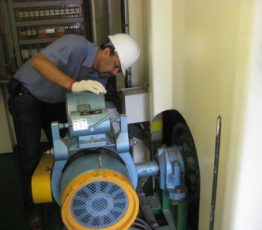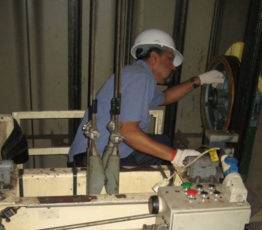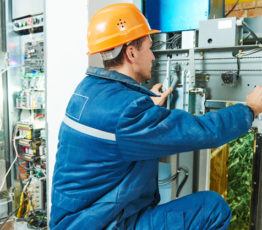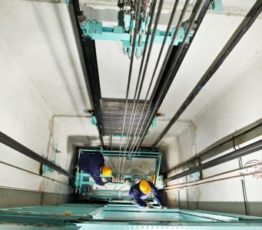- HOME
- ABOUT US
- APPROVALS
- JOBS
- OUR SERVICES
- INSPECTION
- TRAINING
- CONSULTANCY
- IOSH
- PERSONAL CERTIFICATION
- MY FILES
- CONTACT US
- HOME
- ABOUT US
- APPROVALS
- JOBS
- OUR SERVICES
- INSPECTION
- TRAINING
- CONSULTANCY
- IOSH
- PERSONAL CERTIFICATION
- MY FILES
- CONTACT US
© 2025 BSAFE SAFETY. Created for free using WordPress and Kubio
B Safe Safety & Security Consultancy
ELEVATOR
What is an elevator?
An elevator or lift is
a type of vertical transportation device
that moves people or goods between floors (levels, decks) of a building, vessel, or other structure.
Elevators are typically powered by electric motors that drive traction cables
and counterweight systems like a hoist,
although some pump hydraulic fluid to raise a cylindrical piston like a jack.
What are the types of elevators?
- Traction Drive Elevator Systems.
- Roped Hydraulic Elevators.
- Pneumatic Vacuum Elevators for the
Home.
- Winding Drum & Counterweight Chain Drive Home Elevator Systems.
Elevator Types
·
Elevators
are devices that move people and goods vertically within a dedicated shaft that
connects the floors of a building. They became commonplace in the 1850s as
steel and iron structural frames allowed taller construction; however it was
Elisha Otis's safety mechanism that prevented the car from falling that made
elevators popular. In almost all modern multi-floor buildings, elevators are
required to provide universal access.
·
There
are three main types of elevators commonly used: traction with a machine room,
machine-room-less traction, and hydraulic; however, there are variations on
each type.
·
Hydraulic
elevators are supported by a piston at the bottom of the elevator that pushes
the elevator up as an electric motor forces oil or another hydraulic fluid into
the piston. The elevator descends as a valve releases the fluid from the
piston. They are used for low-rise applications of 2-8 stories and travel at a
maximum speed of 200 feet per minute. The machine room for hydraulic elevators
is located at the lowest level adjacent to the elevator shaft.
·
Conventional
Hydraulic Elevators have a sheave that extends
below the floor of the elevator pit, which accepts the retracting piston as the
elevator descends. Some configurations have a telescoping piston that
collapses and requires a shallower hole below the pit. Max travel
distance is approximately 60 feet.
·
Hole-less
Hydraulic Elevators have a piston on either side
of the cab. In this configuration, the telescoping pistons are fixed at
the base of the pit and do not require a sheave or hole below the pit.
Telescoping pistons allow up to 50 feet of travel distance.
Non-telescoping pistons only allow about 20 feet of travel distance.
·
Roped
Hydraulic Elevators use a combination of ropes and
a piston to move the elevator. Maximum travel distance is about 60 feet.
·
Hydraulic
elevators have a low initial cost and their ongoing maintenance costs are lower
compared to the other elevator types. However, hydraulic elevators use more
energy than other types of elevators because the electric motor works against
gravity as it forces hydraulic fluid into the piston. A major drawback of
hydraulic elevators is that the hydraulic fluid can sometimes leak, which can
cause a serious environmental hazard. The environmental risk and high energy
use are two main reasons that hydraulic elevators are not being installed as
often as in the past.
·
Geared and Gearless Traction Elevators with
Machine Room
·
Traction
elevators are lifted by ropes, which
pass over a wheel attached to an electric motor above the elevator shaft.
They are used for mid and high-rise applications and have much higher travel
speeds than hydraulic elevators. A counter weight makes the elevators
more efficient by offsetting the weight of the car and occupants so that the
motor doesn't have to move as much weight.
·
Geared
Traction Elevators have a gearbox that is
attached to the motor, which drives the wheel that moves the ropes.
Geared traction elevators are capable of travel speeds up to 500 feet per
minute. The maximum travel distance for a geared traction elevator is around
250 feet.
·
Gear-less
Traction Elevators have the wheel attached
directly to the motor. Gear-less traction elevators are capable of speeds
up to 2,000 feet per minute and they have a maximum travel distance of around
2,000 feet so they are the only choice for high-rise applications.
·
Geared
traction elevators are middle of the road in terms of initial cost, ongoing
maintenance costs, and energy consumption. Gear-less traction elevators have a
high initial cost, medium ongoing maintenance costs, and use energy a bit more
efficiently than geared traction elevators.
·
It
is important that traction elevator ropes and sheaves are checked for wear on a
regular basis. As they wear, the traction between the sheave and the cables is
reduced and slippage becomes more regular, which reduces the efficiency and can
become dangerous if left unchecked.
·
Traction
elevators have height restrictions that are governed by the length and weight
of the cables or ropes. New materials that are stronger and lighter, such as
carbon fiber, will allow traction elevators to achieve new heights.
·
Machine-Room-Less
elevator are traction elevators that do
not have a dedicated machine room above the elevator shaft. The machine
sits in the override space and is accessed from the top of the elevator cab
when maintenance or repairs are required. The control boxes are located in a
control room that is adjacent to the elevator shaft on the highest landing and
within around 150 feet of the machine.
·
Machine-room-less
elevators have a maximum travel distance of up to 250 feet and can travel at
speeds up to 500 feet-per-minute. MRL elevators are comparable to geared
traction elevators in terms of initial and maintenance costs, but they have
relatively low energy consumption compared to geared elevators.
·
Machine-room-less
elevators are becoming the most popular choice for mid-rise buildings where the
travel distance is up to 250 feet. They are energy efficient, require less
space, and their operation and reliability are on par with gear-less traction
elevators.
·
The
main reason that MRL elevators have been adopted so slowly in the United States
is because the building codes had provisions that didn't allow the motor to be
within the hoist way. This is slowly being changed, but it is worth consulting
with the local authorities before specifying an MRL elevator.
Why elevator inspection
important
Manufacturers
and operators of lifting systems must be confident that elevator constructions
are designed and maintained to safely and reliably carry people, freight or
equipment as well as meet all standardized regulatory mandates.
As
an authorized inspection agency, we can perform the comprehensive series of
inspections legally required of your specific type of elevator. We are also
ready to assist in matters related to elevator design, construction and
modification as well as provide training courses for elevator operators.
With
the support of our experts, you can rest assured that your elevators are both
compliant and operating safely
Our elevator inspection services help you
to attain the highest quality and operational standards for your elevator
equipment and systems. We make sure that you are compliant with all industrial
safety and health regulations requirements and keep installation costs at a
minimum starting in the planning phase. Our wide range of inspection and
support services ensure a high level of safety, identifying hidden defects or
material wear early on to prevent accidents and preserve the value of your
assets
Documentation and Reporting
Upon the completion of the
elevator inspection an initial test report will be issued providing detailed
information about the elevator and all the findings. If any the result of the
inspection will be mentioned clearly of any defect and remark found the site
engineer will be notified about the problem and instructed on how to fix it in
order to pass the inspection.
Later on a safety certificate
will be issued carrying the B Safe Safety Stamp our certificates and initial
reports are made to be easy to understand, simplicity and accuracy are our aim
when it comes to certification and documentation.
B Safe Safety is an authorized
body for analysis, inspection, and certification service in UAE.
© 2025 BSAFE SAFETY. Created for free using WordPress and Kubio



